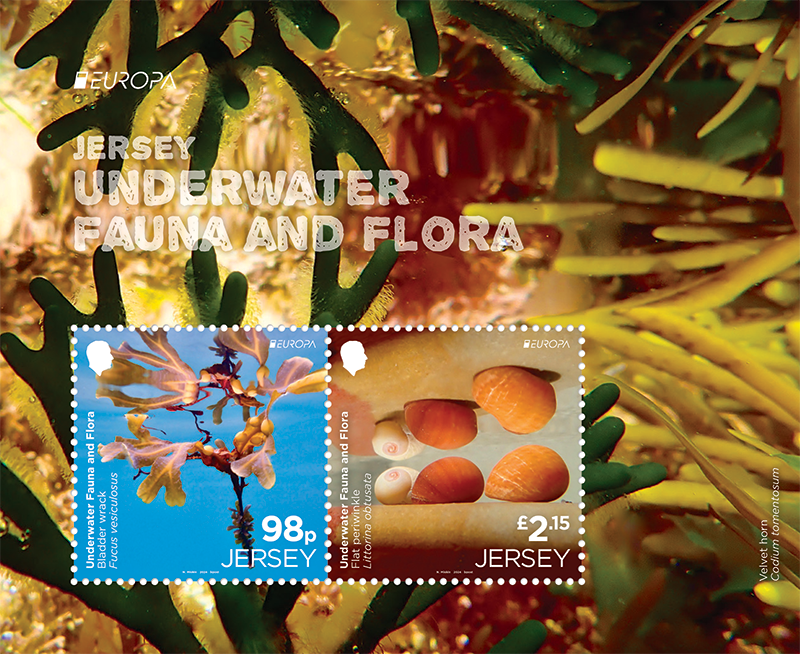Discover Jersey's Underwater World: EUROPA 2024 Stamp Issue
December 19, 2023

Release date: 8 January 2024
Jersey Post proudly presents its latest contribution to the prestigious EUROPA stamp series with "Underwater Fauna and Flora", celebrating the vibrant marine ecosystems found around the island’s coastline. The issue is part of the 2024 PostEurop theme, highlighting the rich biodiversity of European waters.
What is the EUROPA Stamp Series?
The EUROPA series, overseen by PostEurop, brings together European postal operators to explore shared cultural and environmental themes. Each year, countries interpret a selected theme, promoting Europe’s natural heritage and unity. For 2024, the focus is on underwater fauna and flora—an invitation to explore the world beneath the waves.
A Jersey Perspective: Local Photographer Nicola Miskin
The issues features stunning underwater photography captured by Nicola Miskin, a cold-water swimmer and talented local photographer. Nicola shares:
“Swimming in the sea all year round, photographing underwater opened my eyes to a beautiful world. The ever-changing sea is a studio of colours, patterns and reflections.”
Her passion for photography began in 2018 using a worn-out underwater camera. Since then, Nicola has mastered capturing rich detail and fleeting beauty of marine life around Jersey.

Meet the Marine Life: What's Featured on the Stamps
The stamps showcase nine marine species commonly found in Jersey's coastal waters:
Snakelocks Anemone (60p)
A colourful anemone with vivid green tentacles tipped in purple, often home to symbiotic algae that produce energy from sunlight.
- Bladder Wrack (98p – 1st) this type of fauna lives attached to rocks which are found within low shore and show seas about 12m. Their name derives from having snake-like tentacles, which are usually a bright green with purple tips. It's common for them to be home to algae, which produces energy from sunlight.
- Common Limpet (98p – 2nd) cone-shelled grazers that cling to rocks until the tide rises. Known for having the strongest biological structure in the animal kingdom—their tongue!
- Compass Jellyfish (£1.65) named for the compass-like pattern on its bell. This summer visitor uses stinging tentacles to feed on small fish and crustaceans.
- Flat Periwinkle (£2.15) mostly found within seaweed across the lower end of the shore where they feed. The flat periwinkle comes in various colours, which can include orange, olive green, bright yellow and various browns, which make them difficult to spot when within seaweed.
- Sea Lettuce – Ulva lactuca (£2.95) green and translucent, this ruffled seaweed thrives whether attached to rocks or floating freely. Its name nods to its similarity to leafy lettuce.*Lactuca is the scientific name for lettuce.
- Carrageen – Irish Moss (£3.75) can grow up to 20cm long and is commonly found on rocky shores. Carrageen seaweed makes for a striking appearance when underwater due to its fonds which can appear as iridescent blue.
- Great Scallop (£4.85), is a type of mollusc that has two distinct shells. One is curved like a bowl, while the other upper shell is flatter like a lid. Residing within a self-dug hollow in sand or gravely seabeds, great scallops are filter feeders that have the ability to propel themselves across the sea bed by rapidly opening and closing their shells.
Velvet Horn (Souvenir Miniature Sheet) A green algae with soft, hair-like extensions, best viewed underwater where its delicate texture becomes most visible.
Why it matters
This issue celebrates not only Jersey's marine biodiversity but also highlights the importance of conservation, sustainable seas and local artistic talents. Nicola's images provide a rate glimpse into the island's subaquatic world, often seen by the public.
